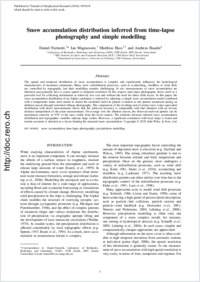Snow accumulation distribution inferred from time-lapse photography and simple modelling
- Farinotti, Daniel Laboratory of Hydraulics, Hydrology and Glaciology (VAW), ETH Zurich, Switzerland
- Magnusson, Jan WSL Institute for Snow and Avalanche Research, Davos Dorf, Switzerland
- Huss, Matthias Laboratory of Hydraulics, Hydrology and Glaciology (VAW), ETH Zurich, Switzerland - Department of Geosciences, University of Fribourg, Switzerland
- Bauder, Andreas Laboratory of Hydraulics, Hydrology and Glaciology (VAW), ETH Zurich, Switzerland
-
24.03.2010
Published in:
- Hydrological Processes. - 2010, vol. 24, no. 15, p. 2087-2097
English
The spatial and temporal distribution of snow accumulation is complex and significantly influences the hydrological characteristics of mountain catchments. Many snow redistribution processes, such as avalanching, slushflow or wind drift, are controlled by topography, but their modelling remains challenging. In situ measurements of snow accumulation are laborious and generally have a coarse spatial or temporal resolution. In this respect, time-lapse photography shows itself as a powerful tool for collecting information at relatively low cost and without the need for direct field access. In this paper, the snow accumulation distribution of an Alpine catchment is inferred by adjusting a simple snow accumulation model combined with a temperature index melt model to match the modelled melt-out pattern evolution to the pattern monitored during an ablation season through terrestrial oblique photography. The comparison of the resulting end-of-winter snow water equivalent distribution with direct measurements shows that the achieved accuracy is comparable with that obtained with an inverse distance interpolation of the point measurements. On average over the ablation season, the observed melt-out pattern can be reproduced correctly in 93% of the area visible from the fixed camera. The relations between inferred snow accumulation distribution and topographic variables indicate large scatter. However, a significant correlation with local slope is found and terrain curvature is detected as a factor limiting the maximal snow accumulation.
- Faculty
- Faculté des sciences et de médecine
- Department
- Département de Géosciences
- Language
-
- English
- Classification
- Meteorology, climatology
- License
-
License undefined
- Identifiers
-
- RERO DOC 18067
- DOI 10.1002/hyp.7629
- Persistent URL
- https://folia.unifr.ch/unifr/documents/301570
Statistics
Document views: 170
File downloads:
- pdf: 266
